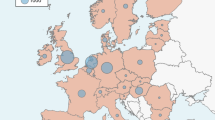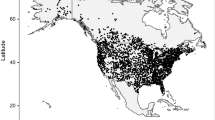Abstract
Citizen science monitoring of common birds often involves volunteers visiting selected survey locations twice per year, with interannual differences in the number of birds detected used to infer population trends. Two processes, changes in the timing of migration and breeding in response to climate change, and changes in the timing of surveys by volunteers, may cause variation in the number of birds detected, leading to biases in inferred population trends. We assessed the magnitude of potential biases using the UK Breeding Bird Survey, comparing survey timing, species phenologies and apparent trend biases between 1994–98 and 2013–17. To control for large-scale geographic effects, we focussed on a subset of 888 surveyed 1 km squares in South-East England. Survey dates became significantly earlier, advancing by 2–4 days on average. We calculated seasonal patterns of bird abundance for 68 species. After standardising these to remove long-term abundance trends, median detection dates were advanced by 0.82 days on average. At the species level, the majority of changes were ± 2 days and only five species showed a significant advancement in median detection date. However, species’ phenological changes alone are capable of inducing between an 8% suppression and 21% enhancement of species’ trends, although the majority are ± 2%. Effects of a similar magnitude are apparent if survey timings are also allowed to change, although different species are affected. Small modifications to the statistical model used to generate trends can control for changes in survey timing, but without additional survey visits, or using data from other sources, we cannot currently control for seasonal variation in detectability. Although the average effects shown here are small, biases could become increasingly important for some species, and we recommend organisers of biodiversity monitoring schemes assess whether their methods are resistant to variations in species phenology and survey timing.
Zusammenfassung
Phänologische Abweichung zwischen Brutvögeln und deren Kartierern und ihre Auswirkungen auf die Schätzung von Bestandsentwicklungen
„Citizen Science “-Monitoring von häufigen Vogelarten umfasst oft Freiwillige, die ausgewählte Zählgebiete zweimal jährlich besuchen, wobei die zwischenjährlichen Unterschiede in der erfassten Vogelanzahl genutzt werden, um auf Bestandsentwicklungen schließen zu können. Zwei Prozesse, zum einen die Veränderungen im zeitlichen Ablauf von Zug und Brut in Anpassung an den Klimawandel und zum anderen die Veränderungen in der Zeitabfolge der Erfassungen durch Freiwillige, können Schwankungen in der erfassten Vogelanzahl verursachen, was zu Verzerrungen in den daraus gefolgerten Bestandsentwicklungen führt. Wir bewerteten das Ausmaß möglicher Verzerrungen anhand der britischen Brutvogelerfassung „Breeding Bird Survey “, indem wir den Erfassungstermin, die Phänologie der Arten und die erkennbaren Verzerrungen der Bestandsentwicklungen zwischen 1994–98 und 2013–17 verglichen. Um für großräumige geographische Einflüsse zu kontrollieren, konzentrierten wir uns auf eine Auswahl von 888 untersuchten 1-km-Quadraten in Südostengland. Erfassungstermine wurden signifikant früher angesetzt, im Durchschnitt um 2–4 Tage vorverlegt. Wir bestimmten den saisonalen Verlauf der Häufigkeit für 68 Vogelarten. Nachdem diese standardisiert worden sind, um langfristige Häufigkeitstrends zu beheben, wurden die medianen Erfassungstermine durchschnittlich um 0,82 Tage vorgezogen. Auf Artniveau betrug die Veränderung mehrheitlich ± 2 Tage und nur bei fünf Arten zeigte sich eine signifikante Vorverlegung des medianen Erfassungstermins. Die phänologischen Veränderungen der Arten allein bewirken bereits Veränderungen von einer 8%igen Abnahme bis zu einer 21%igen Zunahme in den Bestandsentwicklungen, obwohl die Mehrheit ± 2% beträgt. Auswirkungen von ähnlichen Ausmaßen sind erkennbar, wenn man die Erfassungstermine ebenfalls sich ändern lässt, auch wenn verschiedene Arten davon betroffen sind. Kleine Anpassungen des statistischen Modells, das zur Erstellung von Bestandsentwicklungen verwendet wird, können für die Änderungen der Erfassungstermine kontrollieren, aber ohne zusätzliche Begehungen oder der Verwendung von Daten aus anderen Quellen können wir derzeit für die saisonale Variation in der Erfassbarkeit nicht kontrollieren. Obwohl die hier gezeigten durchschnittlichen Auswirkungen gering sind, könnten die Verzerrungen für einige Arten zunehmend bedeutender werden. Wir empfehlen den Organisatoren von Biodiversitätsmonitoringvorhaben zu prüfen, inwiefern ihre Methoden gegenüber einer Variation in der Phänologie der Arten und der Zeitabfolge der Erfassung robust sind.






Similar content being viewed by others
Data availability
The BBS data is available for research and conservation purposes on request by contacting: datarequests@bto.org.
Code availability
Code is available via GitHub (https://github.com/BritishTrustForOrnithology/Phenological_mismatch_J_Ornithol).
References
Boersch-Supan PH, Trask AE, Baillie SR (2019) Robustness of simple avian population trend models for semi-structured citizen science data is species-dependent. Biol Conserv 240:108286
Brereton TM, Botham MS, Middlebrook I, Randle Z, Noble D, Harris S, Dennis EB, Robinson AE, Peck K, Roy DB (2019) United Kingdom Butterfly Monitoring Scheme report for 2018. Centre for Ecology & Hydrology, Butterfly Conservation, British Trust for Ornithology and Joint Nature Conservation Committee
Buckland ST, Anderson DR, Burnham KP, Laake JL, Borchers DL, Thomas L (2001) Introduction to distance sampling. Estimating abundance of biological populations. Oxford University Press, New York
British Trust for Ornithology (2018) BTO/JNCC/RSPB Breeding Bird Survey instructions. https://www.bto.org/sites/default/files/bbs_instructions_2018.pdf. Accessed 31 March 2020.
Caughlan L, Oakley KL (2001) Cost considerations for long-term ecological monitoring. Ecol Indic 1:123–134
Crick HQP, Dudley C, Glue DE, Thompson DL (1997) UK birds are laying eggs earlier. Nature 388:526
Eaton MA, Aebischer NJ, Brown AF, Hearn RD, Lock L, Musgrove AJ, Noble DG, Stroud DA, Gregory RD (2015) Birds of Conservation Concern 4: the population status of birds in the United Kingdom, Channel Islands and Isle of Man. British Birds 108:708–746
Eurostat (2019) https://ec.europa.eu/eurostat/web/regions-and-cities/overview
Greenwood JJD, Robinson RA (2006) Principles of sampling. A handbook. In: Sutherland WJ (ed) Ecological census techniques. Cambridge University Press, New York, pp 11–86
Harris SJ, Massimino D, Balmer DE, Eaton MA, Noble DG, Pearce-Higgins JW, Woodcock P, Gillings S (2019) The Breeding Bird Survey 2019. BTO Research Report 726. British Trust for Ornithology, Thetford
Kéry M, Schmid H (2004) Monitoring programs need to take into account imperfect species detectability. Basic Appl Ecol 5:65–73
Lehikoinen A (2013) Climate change, phenology and species detectability in a monitoring scheme. Popul Ecol 55:315–323
Marchant JH, Hudson R, Carter SP, Whittington PA (1990) Population Trends in British Breeding Birds. BTO, Tring
Massimino D, Gillings S (2018) Updating information on the period of reproduction and prenuptial migration for UK and Irish species included on Annex II of the EU Birds Directive. BTO Research Report 711. British Trust for Ornithology, Thetford
Morrison ML (2002) Wildlife restoration. Techniques for habitat analysis and animal monitoring. Island Press, Washington
Newson SE, Massimino D, Johnston A, Baillie SR, Pearce-Higgins JW (2013) Should we account for detectability in population trends? Bird Study 60:384–390
Newson SE, Moran NJ, Musgrove AJ, Pearce-Higgins JW, Gillings S, Atkinson PW, Miller R, Grantham MJ, Baillie SR (2016) Long-term changes in the migration phenology of UK breeding birds detected by large-scale citizen science recording schemes. Ibis 158:481–496
Newson SE, Woodburn R, Noble DG, Baillie SR, Gregory RD (2005) Evaluating the Breeding Bird Survey for producing national population size and density estimates. Bird Study 52:42–54
Parmesan C, Yohe G (2003) A globally coherent fingerprint of climate change impacts across natural systems. Nature 421:37–42
Pannekoek J, van Strien A (2005) TRIM 3 Manual (TRends & Indices for Monitoring data). Statistics Netherlands, Voorburg
PECBMS (2019) PanEuropean common bird monitoring scheme. https://pecbms.info/
Rubolini D, Møller AP, Rainio K, Lehikoinen E (2007) Intraspecific consistency and geographic variability in temporal trends of spring migration phenology among European bird species. Clim Res 35:135–146
Senyatso K, Sheehan D, Eaton M, Butchart S (2008) Guidelines for the development of Bird Population Monitoring in Africa. BirdLife International & RSPB
Thackeray SJ, Henrys PA, Hemming D, Bell JR, Botham MS, Burthe S, Helaouet P, Johns DG, Jones ID, Leech DI, Mackay EB, Massimino D, Atkinson S, Bacon PJ, Brereton TM, Carvalho L, Clutton-Brock TH, Duck C, Edwards M, Elliott JM, Hall SJG, Harrington R, Pearce-Higgins JW, Høye TT, Kruuk LEB, Pemberton JM, Sparks TH, Thompson PM, White I, Winfield IJ, Wanless S (2016) Phenological sensitivity to climate across taxa and trophic levels. Nature 535:241–245
United States Geological Survey (2019) North American Breeding Bird Survey. https://www.pwrc.usgs.gov/bbs/index.cfm
Wood SN (2017) Generalized additive models: an introduction with R, 2nd edn. CRC Press, Boca Raton
Acknowledgements
We thank the thousands of volunteers who have taken part in the Breeding Bird Survey. The BTO/JNCC/RSPB Breeding Bird Survey is a partnership jointly funded by the BTO, RSPB and JNCC, with fieldwork conducted by volunteers. We are grateful to Eva Šilarová and Petr Voříšek for the information provided. We thank two anonymous reviewers whose comments improved the paper.
Funding
The research was funded by a partnership of the British Trust for Ornithology, the Royal Society for the Protection of Birds, and the Joint Nature Conservation Committee.
Author information
Authors and Affiliations
Contributions
SH organises the Breeding Bird Survey. DM and SG conceived the idea, DM undertook all analyses and DM and SG wrote the paper.
Corresponding author
Ethics declarations
Conflict of interest
There are no conflicts of interest or competing interests.
Additional information
Communicated by T. Gottschalk.
Publisher's Note
Springer Nature remains neutral with regard to jurisdictional claims in published maps and institutional affiliations.
Electronic supplementary material
Below is the link to the electronic supplementary material.
Rights and permissions
About this article
Cite this article
Massimino, D., Harris, S.J. & Gillings, S. Phenological mismatch between breeding birds and their surveyors and implications for estimating population trends. J Ornithol 162, 143–154 (2021). https://doi.org/10.1007/s10336-020-01821-5
Received:
Revised:
Accepted:
Published:
Issue Date:
DOI: https://doi.org/10.1007/s10336-020-01821-5




